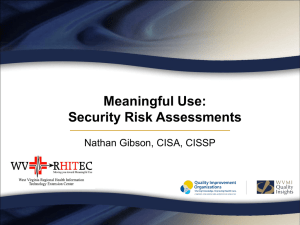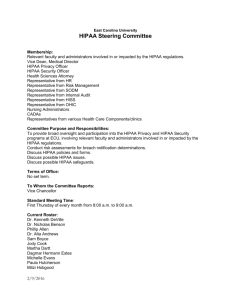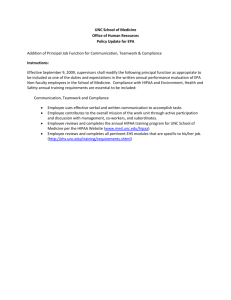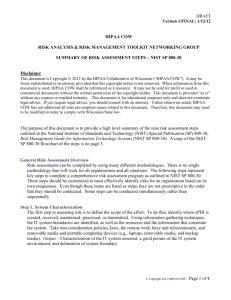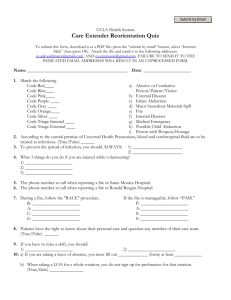Risk Toolkit Guide
advertisement
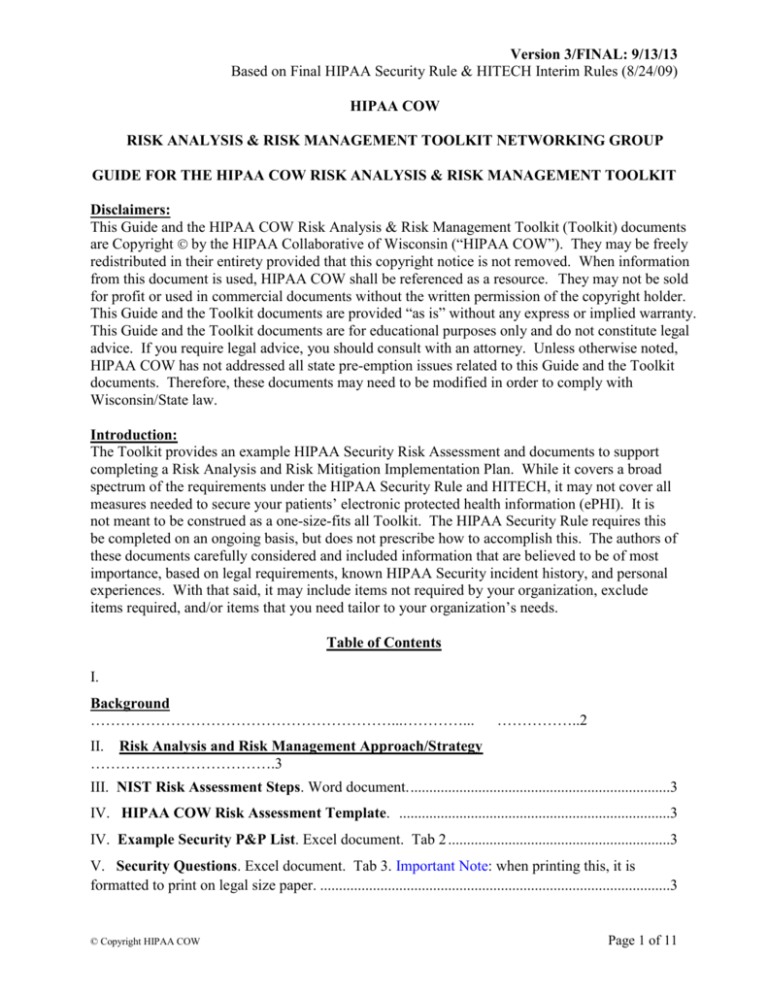
Version 3/FINAL: 9/13/13 Based on Final HIPAA Security Rule & HITECH Interim Rules (8/24/09) HIPAA COW RISK ANALYSIS & RISK MANAGEMENT TOOLKIT NETWORKING GROUP GUIDE FOR THE HIPAA COW RISK ANALYSIS & RISK MANAGEMENT TOOLKIT Disclaimers: This Guide and the HIPAA COW Risk Analysis & Risk Management Toolkit (Toolkit) documents are Copyright by the HIPAA Collaborative of Wisconsin (“HIPAA COW”). They may be freely redistributed in their entirety provided that this copyright notice is not removed. When information from this document is used, HIPAA COW shall be referenced as a resource. They may not be sold for profit or used in commercial documents without the written permission of the copyright holder. This Guide and the Toolkit documents are provided “as is” without any express or implied warranty. This Guide and the Toolkit documents are for educational purposes only and do not constitute legal advice. If you require legal advice, you should consult with an attorney. Unless otherwise noted, HIPAA COW has not addressed all state pre-emption issues related to this Guide and the Toolkit documents. Therefore, these documents may need to be modified in order to comply with Wisconsin/State law. Introduction: The Toolkit provides an example HIPAA Security Risk Assessment and documents to support completing a Risk Analysis and Risk Mitigation Implementation Plan. While it covers a broad spectrum of the requirements under the HIPAA Security Rule and HITECH, it may not cover all measures needed to secure your patients’ electronic protected health information (ePHI). It is not meant to be construed as a one-size-fits all Toolkit. The HIPAA Security Rule requires this be completed on an ongoing basis, but does not prescribe how to accomplish this. The authors of these documents carefully considered and included information that are believed to be of most importance, based on legal requirements, known HIPAA Security incident history, and personal experiences. With that said, it may include items not required by your organization, exclude items required, and/or items that you need tailor to your organization’s needs. Table of Contents I. Background ……………………………………………………...…………... ……………..2 II. Risk Analysis and Risk Management Approach/Strategy ……………………………….3 III. NIST Risk Assessment Steps. Word document. .....................................................................3 IV. HIPAA COW Risk Assessment Template. ........................................................................3 IV. Example Security P&P List. Excel document. Tab 2 ...........................................................3 V. Security Questions. Excel document. Tab 3. Important Note: when printing this, it is formatted to print on legal size paper. .............................................................................................3 © Copyright HIPAA COW Page 1 of 11 Version 3/FINAL: 9/13/13 Based on Final HIPAA Security Rule & HITECH Interim Rules (8/24/09) A) NIST Threat Overview……………………………………………………………………4 B) This worksheet includes an example list of questions and a way for your organization to document how you are meeting (in compliance with) the HIPAA Security Rule and HITECH security requirements. ..........................................................................................4 C) Inventory Asset List. Excel Document. st .........................................................................4 D) Network Diagram Example.................................................................................................5 E) NIST Risk Definitions & Calculations. Word document. ..................................................5 VI. Risk Mitigation Implementation Plan………………………………… ..............................5 A) NIST Risk Mitigation Activities. Word document. ...........................................................5 B) Office Use Only. Excel Document. It is the seventh worksheet on the HIPAA COW Risk Assessment Template spreadsheet. .......................................................................................6 VII. Risk Analysis Report Template. Word Document. .............................................................6 VIII. Risk Management Policy..……………………………………………………………...…7 IX. HIPAA COW OCR Audit Protocol..………………………………………………………7 X. Toolkit References …………...……………………………………..……………..…………7 XI. Other Available Risk Resources…………………………..…………………….…………..7 Background This Toolkit is based on many of the methodologies described in the National Institute of Standards and Technology (NIST) Special Publication (SP) 800-30, Risk Management Guide for Information Technology Systems (NIST SP 800-30) (2002) 1 and NIST SP 800-66, An Introductory Resource Guide for Implementing the Health Insurance Portability and Accountability Act (HIPAA) Security Rule. The reason these were used as a guide for building this Toolkit is that NIST documents are referenced and used by the U.S. Department of Health and Human Services. While the government does not require that NIST be used, in the Office for Civil Rights Guidance on Risk Analysis Requirements under the HIPAA Security Rule document, it states about NIST documents, “non-federal organizations may find their content valuable when developing and performing compliance activities”. It is important to note that there are a myriad of other ways to complete a HIPAA Security Risk Assessment, many of which may provide you with a more thorough and accurate summary of threats and vulnerabilities to your patients’ ePHI. It may be beneficial for your organization to review the Toolkit References listed at the end of this Guide to gain a better understanding of how to conduct a Risk Analysis and implement a successful Risk Management program in your organization. 1 NIST has since released a revision to NIST SP 800-30. The original NIST SP 800-30 from 2002 was used in the development of this Toolkit and its supporting documents. NIST SP 800-30 (2002) is available on the HIPAA COW website under the Risk Toolkit tab. © Copyright HIPAA COW Page 2 of 11 Version 3/FINAL: 9/13/13 Based on Final HIPAA Security Rule & HITECH Interim Rules (8/24/09) It is also important to note that in some of the Toolkit documents, references to products are included. These references are provided for examples only. They are not required to be used and are not necessarily the best products available to use. They were merely known at the time as products available that could potentially be considered by organizations to use. Organizations considering using new products should research and evaluate all available and applicable products at that time. Risk Analysis and Risk Management Approach/Strategy The first goal of completing a Risk Analysis is to identify threats and vulnerabilities in your organization that have the potential of negatively impacting the confidentiality, integrity, and availability of ePHI. After ranking threats and vulnerabilities, the next steps are to mitigate the risks. This is accomplished by taking reasonable and appropriate security measures to protect ePHI from these threats and vulnerabilities. Mitigation efforts may be technical and nontechnical in nature and will vary between organizations. This Risk Management process and measures taken is often documented in a Risk Mitigation Implementation Plan. This Toolkit is a work in progress. More documents will be added to further assist organizations in their efforts to complete a Risk Analysis, Risk Assessment, and their Risk Management strategy. This Toolkit is not considered to be all inclusive. There are other aspects to completing risk assessments/analyses that this Toolkit does not cover (e.g. vulnerability assessments, penetration testing, etc.). Following is a brief summary of the documents in the Toolkit and how to use them. A recommended approach is to use them in the order listed. 1) NIST Risk Assessment Steps. Word document. A) This document provides a high level summary of the nine risk assessment steps recommended in the NIST SP 800-30 (2002). These are the steps to take to identify and rank risks, develop controls, and document results of the risk assessment. B) A copy of the NIST SP 800-30 (2002) flowchart is also included which provides a graphical display of these steps. HIPAA COW Risk Assessment Template. Excel document. Depending on how this spreadsheet opens, you may need to click on the small left or right arrow keys located at the bottom of the spreadsheet to get to the worksheets described below that are in this document. 2) Example Security P&P List. Excel document. Tab 2 A) Included is a list of policies and procedures (P&Ps) your organization may write to cover the requirements of the HIPAA Security Rule. B) It is an example list only. Your organization is not required to name your P&Ps this way. C) The policies are listed in order of potential “importance”, or criticality to the confidentiality, integrity, and availability of ePHI. It is recommended that your organization take some time to determine if this is order is consistent with your mission, vision, and/or organizational culture. © Copyright HIPAA COW Page 3 of 11 Version 3/FINAL: 9/13/13 Based on Final HIPAA Security Rule & HITECH Interim Rules (8/24/09) D) This same list is included in the same order in the Security Questions worksheet as a cross-reference. 3) Security Questions. Excel document. Tab 3. Important Note: when printing this, it is formatted to print on legal size paper. A) This worksheet includes an example list of questions and a way for your organization to document how you are meeting (in compliance with) the HIPAA Security Rule and HITECH security requirements. Recommended Actions were updated in 2013 to include questions from the OCR Audit Protocol. B) This worksheet is currently sorted by the example HIPAA Security P&P List. It is not sorted by the order in which it appears in the HIPAA Security Rule. It is important to note that several sections of the HIPAA Security Rule are often pulled together as they are interrelated. i) To better understand what this means relative to the HIPAA Security Rule: (1) For efficient and effective implementation of the HIPAA Security rule, HIPAA COW took an approach to logically group similar topics in the HIPAA Security Rule. Standards and Implementation Specifications are grouped in this worksheet by the example Security P&P name and also sorted by the order in which the P&P name appears on the Example Security P&P List. Therefore, you will find that not all Implementation Specifications are always grouped under the Standard in which it is listed in the HIPAA Security Rule. C) Each row includes information about the HIPAA Security rule or HITECH, a vulnerability/threat pair, an assessment question, recommended controls, etc i) Refer to Appendix A which provides a summary of what the different text colors in the rows mean, definitions of the Current Status column, a key that describes what is included in and how to use each column, and other recommendations for documenting your current status. D) NIST Threat Overview. Word Document. i) Use this document while completing the Risk Management questions on the Security Questions worksheet. ii) This document is a Threat Identification Overview provided in NIST SP 800-30. It includes definitions of a threat, threat source, threat action, threat sources, and vulnerability. E) Threat Source List. Excel Document. Tab 4 i) Use this document while completing the Risk Management questions on the Security Questions worksheet. ii) This is an example list of potential threat sources to the confidentiality, integrity, and availability of your organization’s ePHI. iii) Use the document to identify and create your own list of threat sources to your organization’s ePHI. iv) The bolded items on this list are those that are believed to be the most common threat sources to occur in Wisconsin, as determined by the HIPAA COW Risk Management Networking Group at the time this was developed. v) Review this list carefully and modify it to include threat sources that may impact the confidentiality, integrity, and/or availability of your patient’s ePHI. Consider previous security incident reports, system and facility break-in attempts, unplanned © Copyright HIPAA COW Page 4 of 11 Version 3/FINAL: 9/13/13 Based on Final HIPAA Security Rule & HITECH Interim Rules (8/24/09) outages, and possible natural or man-made disasters your facility may be susceptible to when identifying vulnerability/threat pairs. F) Inventory Asset List. Excel Document. Tab 5 i) Use this document while completing the Risk Management and Contingency Plan questions on the Security Questions worksheet. ii) This is an example list of assets your organization may have. iii) Update this list to include a list of the communication, hardware, and software that your organization uses. Document for each: a brief description, its function, how it is used, its criticality level, quantity, etc. iv) Important Notes: (1) This spreadsheet is formatted to print columns A through G. Columns H through AA are additional items that are often important to document and maintain for systems. (2) The different colors in the header row are used only as a means to color code the different types/groups of information. (3) This spreadsheet is intended to document a small organization’s hardware and software. Larger organizations would use a configuration management or other asset tracking database. G) Network Diagram Example. PDF document. i) Use this document while completing the Contingency Plan questions on the Security Questions worksheet. ii) This includes an example of a very simple, small practice network diagram. Other examples are available on the Internet (search for “network diagram”). iii) Network diagrams display how an organization’s systems and network is set up, interdependencies, identify critical interdependencies, etc. They are useful to have during emergencies so that IT staff can easily identify how to get the systems back up and running. H) NIST Risk Definitions & Calculations. Word document. i) This document is extracted directly from NIST SP 800-30 (2002). It includes definitions of likelihood, impact, and risk levels. Use the Likelihood & Impact definitions to select the correct likelihood level and magnitude of impact on the Risk Mitigation Implementation Plan. ii) Use this document to help you complete the Likelihood and Impact for those assessment questions that you identified as “Not Complete” and “In Progress” on the Security Questions worksheet. iii) After entering the Likelihood level and magnitude of Impact levels, the spreadsheet will automatically calculate the Risk Level. iv) It is common for organizations to first review and mitigate the High & Moderate Risk levels identified. 4) Risk Mitigation Implementation Plan. Excel Document. Tab 6 A) This Risk Mitigation Implementation Plan follows the steps presented in the NIST Risk Mitigation Activities document (see ii below). It includes the seven steps recommended by NIST to take to reduce threats and vulnerabilities to a reasonable and appropriate level. © Copyright HIPAA COW Page 5 of 11 Version 3/FINAL: 9/13/13 Based on Final HIPAA Security Rule & HITECH Interim Rules (8/24/09) B) Once you have completed scoring the questions on the Security tab, press the Complete Form button. This will transfer the following columns to the Risk Mitigation Implement Plan: i) Risk/Vulnerability Threat Pair (H) ii) Risk Level (N) iii) Recommended Actions and Controls (O) (1) for those questions where the risk score is greater than 50 to the Implementation Plan Tab 6. (Note: macros must be enabled for the button to work). This will save you considerable time copying and pasting! iv) NIST Risk Mitigation Activities. Word document. (1) This document is extracted directly from NIST SP 800-30 (2002). It provides a methodology and summary of actions to take to mitigate identified risks. (2) Use this document while working through each of the risk mitigation steps. Document the details of these risk mitigation implementation plan steps as you complete them in this worksheet. (a) Document all decisions made and rationale for the decisions on this worksheet. (b) When determining what to include in the Evaluate Control Options, Conduct Cost Benefit Analysis, and Select Controls columns, consider the following: (i) Sensitivity of the data and the system (ii) Amount of PHI (iii) Mobility of the system using the data (can it be used remotely from any location and if yes, when it is accessed is it secure, such as through an encrypted connection) (iv) Frequency of use (v) Number of users (vi) Consideration of previous security incidents (vii) Effectiveness of recommended controls (e.g., system compatibility) (viii) Legislation and regulations (ix) Organizational policy (x) Operational impact (xi) Safety and reliability (xii) Cost to implement recommended controls C) Documentation from your Risk Mitigation Implementation Plan may be requested if you are audited by the Office for Civil Rights. D) After mitigating these risks, follow the above steps for the low risk levels identified on the Security Questions worksheet. E) Office Use Only. Excel Document. It is the seventh worksheet on the HIPAA COW Risk Assessment Template spreadsheet. i) Information from this worksheet provides a key that “feeds” into the Security Questions worksheet. More specifically, it provides the only selections that can be made for the Current Status, Likelihood, and Impact columns. ii) Do not delete or change information on this worksheet or you risk disabling the functionality of the document. 5) Risk Analysis Report Template. Word Document. © Copyright HIPAA COW Page 6 of 11 Version 3/FINAL: 9/13/13 Based on Final HIPAA Security Rule & HITECH Interim Rules (8/24/09) A) After creating your Risk Mitigation Implementation Plan, use this template to create a Risk Analysis Report. This Report will outline the methodology and steps taken to complete the Risk Analysis for your organization, identify safeguarding measures currently in place, describe and rank risks to the confidentiality, integrity and/or availability of your organization’s ePHI, and provide recommended controls to address these risks. B) Provide this report to your executive leadership team, Board of Directors, etc. Request their approval and support to put in place the recommended controls. C) Then begin putting the selected controls in place and document all steps/actions taken on the risk mitigation implementation plan. 6) Risk Management Policy. Word Document (1/2013) A) This is a policy template for your organization to use to document your risk management process. It follows the same seven steps outlined in our other documentation. 7) HIPAA COW OCR Audit Protocol. Excel Spreadsheet A) The HIPAA COW Risk Management group reviewed the OCR audit protocol and added a column identifying which Risk Toolkit security questions map to the audit questions The last column includes the question numbers that currently are believed to cover some or all of the audit protocol requirements for each specific item. 8) Toolkit References A) Office for Civil Rights Guidance on Risk Analysis Requirements under the HIPAA Security Rule, July 14, 2010. http://www.hhs.gov/ocr/privacy/hipaa/administrative/securityrule/rafinalintro.html B) Office for Civil Rights HIPAA Privacy and Security Regulations: http://www.hhs.gov/ocr/privacy/hipaa/administrative/index.html C) Office for Civil Rights HIPAA Security Series: http://www.hhs.gov/ocr/privacy/hipaa/administrative/securityrule/securityruleguidance.ht ml D) Office for Civil Rights HIPAA Case Examples and Resolution Agreements: http://www.hhs.gov/ocr/privacy/hipaa/enforcement/examples/index.html E) Office for Civil Rights HIPAA Enforcement Highlights: http://www.hhs.gov/ocr/privacy/hipaa/enforcement/highlights/index.html F) NIST Special Publications: http://csrc.nist.gov/publications/PubsSPs.html i) NIST SP 800-30: Risk Management Guide for Information Technology Systems, July 2002 ii) NIST SP 800-34: Contingency Planning Guide for Federal Information Systems (Errata Page - Nov. 11, 2010) iii) NIST SP 800-53 Rev 3: Recommended Security Controls for Federal Information Systems and Organizations (August 2009) iv) NIST SP 800-53 A: Guide for Assessing the Security Controls in Federal Information Systems and Organizations, Building Effective Security Assessment Plans (June 2010) v) NIST SP 800-66: An Introductory Resource Guide for Implementing the Health Insurance Portability and Accountability Act (HIPAA) Security Rule, October 2008 © Copyright HIPAA COW Page 7 of 11 Version 3/FINAL: 9/13/13 Based on Final HIPAA Security Rule & HITECH Interim Rules (8/24/09) G) HIPAA/HITECH Privacy & Security Checklist. WVMI & Quality Insights, Regional Extension Center, Privacy & Security Community of Practice, January 7, 2011. H) Risk Analysis Report Template. Quality Insights of Delaware, Regional Extension Center, Privacy & Security Community of Practice, January 7, 2011 v.1. I) HIPAA Risk Assessment, Risk Analysis Report, Network Diagram and Other Tools. MetaStar/WHITEC, 2011. 9) Other Available Risk Resources A) ISO 27000 Series. http://www.27000.org/ Version History: Current Version: 9/13/13 Prepared by: Mary Koehler, ProHealth Care Bethany Seeboth, Froedtert Health Previous Version: 7/2/12 Prepared by: Holly Schlenvogt, MSH, CPM, MetaStar/WHITEC © Copyright HIPAA COW Reviewed by: Sue Alwin-Popp, Edgerton Hospital & Health Services Maggie Fuchs, Monroe Clinic Colleen Galetka, Rusk County Memorial Hospital Lois Kallunki, WISHIN Wayne Pierce, Aspirus, Inc. Holly Schlenvogt, HRT Consulting, LLC Jeff Thompson, WI Department of Health Services Amy Wolfgram, GHC of Eau Claire Content Changed: General updates to match supporting documents that have been updated. **You may request a copy of the all the changes made in this current version by contacting administration at admin2@hipaacow.org. Reviewed by: Kathy Argall, Co-Founder and CEO, InfoSec Compliance Advisors Cathy Boerner, JD, CHC, President, Boerner Consulting, LLC Ginny Gerlach, Information Security Officer, Ascension Health Lee Kadel, MMOT, EMBA, GHSC, GSEC, Information Security Analyst – Specialist, Wheaton Franciscan Healthcare Jim Sehloff, MS, MT(ASCP), Information Security Analyst, CareTech Solutions Kirsten Wild, RN, BSN, MBA, CHC, Wild Consulting, Inc. Page 8 of 11 Version 3/FINAL: 9/13/13 Based on Final HIPAA Security Rule & HITECH Interim Rules (8/24/09) Appendix A: HIPAA COW Risk Assessment Spreadsheet Key 1) Text colors A) Rows in which the text is black are questions based directly off regulation language. B) Rows below these in which the text is green includes items that support the intent of the requirements (of the question in black above it). These include additional questions to help identify how you are meeting legal requirements and/or industry best practices. 2) Assessment questions that state: “No questions asked…informational only”. These include language that is in the Security Rule, but do not require security measures be taken. 3) Current Status column: A) Select the applicable Current Status from the drop down for each of the questions. Only identify a question as “Complete” if all required measures are in place and it is consistently followed. If you have a written policy, for example, but it is not consistently followed, indicate it is “In Progress”. i) Complete: the item has been written, implemented, and is consistently followed ii) In Progress: the item has been identified, is currently being addressed, or is written (or partially written), but not fully implemented and/or consistently followed iii) On Hold: the item is not currently complete, and is not currently being addressed for reasons such as awaiting approvals, budgeting, resource allocation, etc. iv) Not Complete: the item has not been addressed v) Unknown: it is not certain if this item has been completed or is in progress vi) N/A: this item is not required to be completed or is not applicable to this organization’s security compliance requirements B) Document details of the current status in the Current State/Status Column. Include items such as policy and procedures names in place, technology used, and other safeguarding mechanisms/procedures in place. © Copyright HIPAA COW Page 9 of 11 Version 3/FINAL: 9/13/13 Based on Final HIPAA Security Rule & HITECH Interim Rules (8/24/09) The below key describes what is included in each column on the “Security Questions” worksheet in the HIPAA COW Risk Assessment Template spreadsheet. Policy # Reg # This is the regulation number A listed in numbering the system HIPAA created for Security these Rule or questions. HITECH. Reg Standard When listed, this is the “header” name of the When listed, regulation. For the Security this is the Rule, listed in parenthesis is regulation in the main section it is under in which this the Security Rule (i.e. General requirement rules, Administrative, is located Physical, or Technical (HIPAA Safeguards, Organizational or Security & P&Ps & documentation HITECH). requirements). Risk Vulnerability/Threat Pair Identifies the vulnerability(s) (flaw or weakness) associated with your organization’s environment should a threat source exploit it. Threat sources listed are those most commonly known to happen in Wisconsin. There are likely more that need to be considered. © Copyright HIPAA COW Assessment Question This assessment question is used to determine if your organization has P&Ps or other measures in place to prevent the vulnerability/threat pair from happening, as required or recommended by the particular law, or that meets known best practices. A/R This column is for the Security Rule only; A=Addressable, R=Required (refer to the definitions of addressable and required to determine how to meet these requirements). Implementation Specification This is the actual When listed, this regulation text; is the “header” when the law name for the is lengthy, key Implementation points of the Specification requirements which are always are under Standards. summarized. Current Status This is used to document whether your organization has measures in place to meet compliance with the applicable regulation or best practices. Select from the drop down box: Complete; In Progress; Not Complete; Unknown; or Not Applicable. Page 10 of 11 Legal Requirements Current State/Comments Use this column to document a summary of the P&Ps, technology, and other measures your organization has in place, or are about to implement, to prevent the vulnerability/threat pair from happening. Version 3/FINAL: 9/13/13 Based on Final HIPAA Security Rule & HITECH Interim Rules (8/24/09) Likelihood (.1, .5, or 1) Impact (10, 50, or 100) Risk Level By multiplying the likelihood by the impact Likelihood level, this calculation that a threat represents the degree or will attempt level of which ePHI may to exercise a be exposed or vulnerability Impact level compromised if a given given (magnitude) vulnerability were existing or if a threat exercised. There is a planned actually formula built into this security exercised a worksheet that controls vulnerability automatically calculates (NIST SP (NIST SP this for you (NIST SP 800-30): 800-30): 800-30): .1=Low; .1=Low; 1-10=Low; .5=Medium; .5=Medium; >10-50=Moderate; 1=High 1=High >50-100=High © Copyright HIPAA COW Recommended Actions/Controls Red text = from CAPs with OCR Recommendations included here are intended to help your organization take measures necessary to prevent or minimize the risk that the vulnerability/threat pair will happen. The controls listed are not considered allinclusive or one-sizefits all. Your practice should tailor the controls as appropriate for your organization. Policy/ Procedure This includes a generic policy or procedure name. The reason for this is to help organize the Privacy, Security, & HITECH regulations into topics. These may be similar to policy names your organization has in place. The spreadsheet is currently sorted by this column to keep the policy topics together. Page 11 of 11 HIPAA COW Reference Document This is a Resource list. The HIPAA COW documents listed include information that may help your organization meet the Recommended Actions/Controls and ultimately the HIPAA Security Rule & HITECH requirements. Many of the documents are P&Ps you may use as a template to write your organization’s P&Ps.
